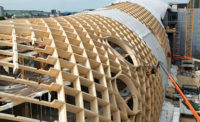Mississauga, Canada
Instead of the boxlike apartment and commercial towers in cities everywhere, architect Yansong Ma, principal of Beijing-based MAD, prefers structures that are “organic and soft.” In his 2006 competition-winning entry for a residential high-rise in Mississauga—a municipality of 734,000 people about 16 miles west of downtown Toronto—Ma proposed a 56-story tower that has since been nicknamed the “Marilyn” for its sensuous and curved form. The building, partof the five-tower, 11-acre Absolute City Centre condominium complex, has elliptical floor plates that rotate around a central core to create a subtly twisting and sculptural profile. The unusual geometry is emphasized by the edges of floor slabs that project beyond floor-to-ceiling window walls, providing wraparound terraces and vantage points for residents to take in views of Lake Ontario and the Toronto skyline.
The strategy has proved a commercial success. The tower sold out just days after plans for its 427 apartments were put on the market in the summer of 2007. Response was so enthusiastic that the site’s owners, Cityzen Development Group and Fernbrook Homes, immediately decided to develop an adjacent parcel, commissioning the then relatively unknown architects for a second tower. According to Ma, the clients simply asked for a carbon copy of Marilyn, but his firm created a slightly simpler scheme for a 50-story, 453-unit building whose floor plates are each rotated one degree in relation to the floor below (the rotation of the taller structure’s floor plates varies, giving it a more voluptuous shape). “The two are subtly different, but are members of the same family,” says Ma.
The shorter tower is now nearing completion while residents are already moving into its more curvaceous sibling. Both feature poured-in-place, flat-plate construction typical for the region. Although the floor slabs are relatively conventional, realizing the twisting geometry required columns that corbel and a different structural design for every level, notes Sigmund Soudack, principal of an eponymous structural engineering firm based in Toronto. Mitigating the heat loss through the cantilevered balconies also provided a key challenge, according to Soudack, who helped devise a method of reducing so-called “cold bridging” between the interior and exterior portions of the slabs—one that was more cost-effective than proprietary thermal break systems from Europe.
The $180 million buildings’ curves and twists are not without liabilities, such as some small and awkwardly shaped rooms that could make arranging furniture problematic. However, buyers seem undeterred. The most recently sold condo in the MAD buildings garnered $470 per square foot, well above the Mississauga average, say the developers. Apartment shoppers who do not want a bedroom with a triangular or trapezoidal plan, but who are enamored of the towers’ contours might consider units in the more prosaic high-rises nearby that offer views of the sculptural buildings. According to some sources, those apartments are also fetching a premium.
People |
Products |










